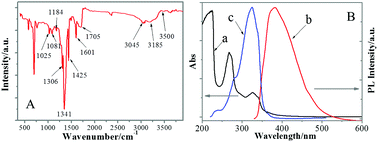Multiplexed ratiometric photoluminescent detection of pyrophosphate using anisotropic boron-doped nitrogen-rich carbon rugby ball-like nanodots†
Abstract
The shape of nanoparticles is decisive for their intrinsic physicochemical properties, as well as for the anisotropic behavior of individual particles in many instances. Herein, boron-doped nitrogen-rich carbon rugby ball-like nanodots (BNCRDs) have been synthesized by a heterophase polymerization route at a vital mass ratio of phenylboronic acid and uric acid in the precursor solution. Unexpectedly, the as-prepared BNCRDs showed stable dispersions of ellipsoidal carbonaceous polymer nanodots (rugby ball-like structures that are approximately 150 nm in length) as novel carbon dot derivatives. The anisotropic BNCRDs are water-soluble compounds that have highly enhanced photoluminescence (PL), which is accompanied by a large red shift of the emission peak upon the addition of Hg2+ and is nearly quenched upon the addition of Cu2+. This is due to the chelation-enhanced fluorescence property of the BNCRDs following Hg2+ complexation with sterically efficient heteroaromatics in the BNCRDs and the chelation enhancement quenching effect of the BNCRDs following Cu2+ complexation with the N/O donor atoms of the surface of the BNCRDs, respectively. Importantly, the BNCRD PL, which is changed by Hg2+ and Cu2+, exhibits high selectivity and sensitivity for the pyrophosphate ion (PPi) in the ranges 50 nM–280 μM and 10 nM–100 μM through a photoluminescent reset process, respectively, and could be attributed to the effective coordination/chelation interactions between Hg2+/Cu2+ and the plentiful oxygen groups of PPi. These results indicate that anisotropic BNCRDs can act not only as a ratiometric sensor for Hg2+ but also as a dual-mode PPi-selective sensor via ratiometric displacement and a competitive mechanism. With the broad diversity in the molecular backbone of the carbon dots via rich chemical routes, anisotropic BNCRDs have been developed with unique structural, electrical, and attractive functions, which greatly expands the research horizon of carbon-based composites.



 Please wait while we load your content...
Please wait while we load your content...